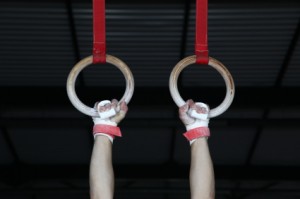Trampolining and tumbling go together hand in hand. Trampolining involves doing all sorts of acrobatic tricks on a trampoline which provides much more height. Tumbling involves doing the same or similar moves on the floor (and with gymnastic spring floors more height can be had).
I’ve mentioned this before. When I first started doing gymnastics I never really used the trampoline. My idea was that I should be able to do all the moves without artificial apparatus. Basically I wanted to be able to do every move outside.
The problem with this idea is that the trampoline is such a useful tool. Although it easily allows you to get tons of air without needed to generate it yourself (by jumping off the ground for instance) you need to control your body in the air. The same control and acrobatic ability in the air is applicable to being on a trampoline or not. It doesn’t really matter.
So even if you only want to do moves outside like I did, the trampoline is a useful tool for getting there.
Just ask Damien Walters. One of the best out there in free running and all manner of acrobatic stunts. One of his primary training methods and tools is the trampoline even competing in the trampoline world championships along with doing all manner of stunts in the gym and out.
For this reason you should use everything available to you. Set goals for tricks you can do on a trampoline. If you need ideas on getting started check out the Trampoline Handbook. In it you’ll find 48 different moves to work on. These range from basic to intermediate. From there the world of trampolining really opens up. Work on doing more complex tricks as well as stringing several more basic tricks together.
Here’s a video showing some amazing trampolining stunts from Adam Menzies along with some other moves at the end.
Want to do a twisting backflip? Do it on the trampoline first and nail it down, before moving onto the floor. Not to mention a trampoline can just be a lot of fun.
When it comes to tumbling on the floor you should follow the same progressions. Work on what you can and build from there. For a wide range of moves (248 to be exact) check out Tumbling Illustrated. And again, do more complex moves and focus on stringing moves together.
The truth is just about anyone can build up decent acrobatic skills if they work on it with persistence. You may not be trying out for Cirque du Soleil anytime soon but you’ll master moves few people can do.
Trampolining and tumbling skills are well worth going after. Working on one will help the other and vice versa. Use the combination and get better starting today.






 2. The Equipment.
2. The Equipment.

